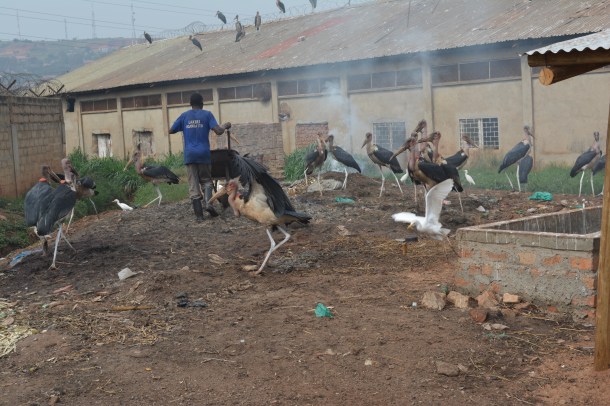
Waste disposal at Wambizzi Pig cooperative society abattoir (Photo credit:ILRI/Brian Kawuma)
Written by Ekta Patel and Kristina Roesel
In early June this year, the BuildUganda research for development project was launched at a workshop with stakeholders. One of the four components of the project is focused on improving veterinary public health in Uganda. During the workshop, component leaders shared their aims and plans for this component, soliciting feedback and guidance from stakeholders on its focus, deliverables, partnerships and field sites.
This ‘veterinary public health’ component specifically aims to improve occupational health for meat handlers by reducing the risks they face and providing training, leading to improved quality and safety of food being produced and available in the market.
Historically, the veterinary profession in Uganda focused mostly on animal health in primary production, however, with increased wealth and meat consumption, the work portfolio of veterinarians has expanded to give more attention to food safety and consumer protection. Veterinary Public Health (VPH) is a relatively new focus in the veterinary sector in Uganda targeted towards OIE recommendations that the country’s abattoir infrastructure are improved, and targeted training be provided to people engaged in meat handling, preparation and inspection.
The VPH component has two major areas of activities: One is capacity building of people involved in meat safety. This includes abattoir personnel, meat transporters, meat inspectors, butchers, laboratory personnel and the consumers. BuildUganda will roll out a training program to improve good hygienic practices to avoid contamination of meat between abattoirs to retail that will help make meat safer for consumers.
Alongside the training, the second emphasis is on research, using selected abattoirs and slaughterhouses as ‘sentinels’ for the wider program to test whether diseases such as PPR or RVF are present. The project will also assess the exposure of slaughterhouse staff to various zoonotic diseases like brucellosis and leptospirosis, exploring if and how this could be a basis for the government to developing a routine surveillance program informed by the findings of this research.
During the breakout sessions with the stakeholders, a lot of good recommendation were made on how to complement the activities through engagement with the private sector (who have an interest in adopting and scaling the training curriculum for hygienic meat handling), engagement with other initiatives such as the EU-funded BEEF project that is developing a market-oriented and environmentally sustainable beef meat industry in Uganda, and collaboration with the universities to improve the meat hygiene curriculum.
2019 activities include consolidating training materials for butcher and meat handler training, streamlining, translating into local languages and rolling out trainings in 2020, and setting up the abattoir-based sentinel studies.
BuildUganda is a research for development collaboration to prevent and tackle animal diseases and zoonoses in Uganda. Led by ILRI and MAAIF, it mobilizes national and international research and development partners from Uganda, Kenya and Germany. The five-year program is funded by the Federal Ministry for Economic Corporation and Development (BMZ) and the CGIAR research programs on Livestock and on Agriculture for Nutrition and Health (A4NH).
For more information, contact Kristina Roesel, program coordinator, k.roesel@cgiar.org
Additional information: